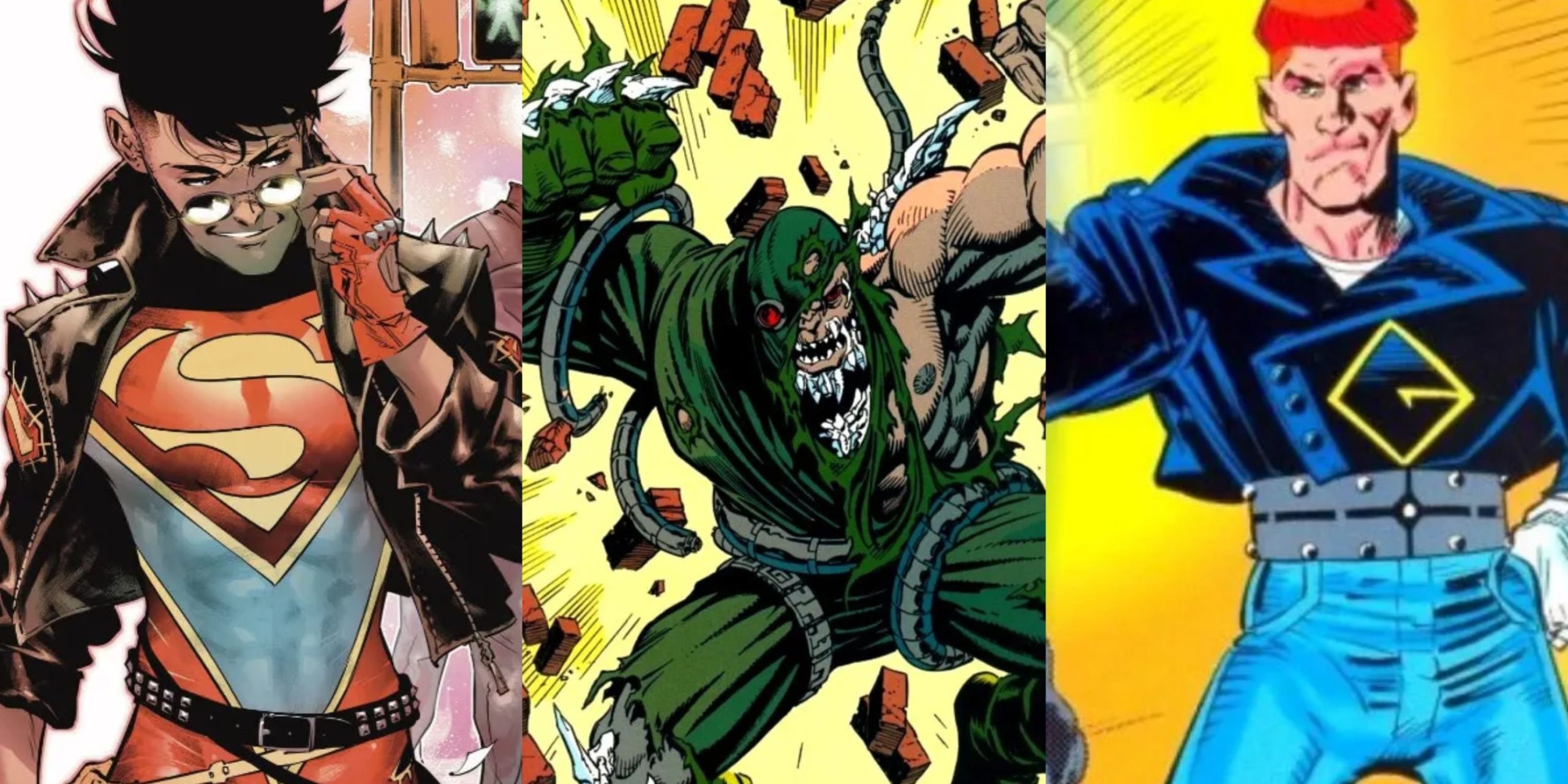DC Comics has a wide range of heroes and villains who populate its eccentric and creative world of the ongoing battle between good and evil. DC has always excelled in science fiction, exploring themes of cosmic horror, time travel and contact with alien life. Throughout all of this scientific ingenuity and experimentation, the use of clones replicated some of the company’s greatest characters.
DC’s clones present a range of threats and heroes, from Superboy to Doomsday. The prominence these characters play in the universe ranges from short stints in a single run to full-fledged members of superhero teams. Clones have always made for an intriguing idea, and DC has made good use of the idea.
RELATED: 10 Silver Age DC Characters Better Than Their Golden Age Counterparts
10 Joseph Gardner
Joseph Gardner was created when a race of alien beings, the Draal, attempted to copy the genetic material of Guy so that they could have a secret agent dispatched to Earth. After some interference from Guy in the cloning process, Joseph emerged with the hero’s memories but a notably different temperament.
Joseph Gardner didn’t just escape to Earth, he actually posed as the real Guy, going so far as to join the Justice League in the hero’s place. However, he proved too unstable and, despite being able to fend off the JLA, was eventually defeated by a triumphant Guy, along with his fellow Lanterns.
9 Heretic
Heretic is both one of DC’s coolest and creepiest clones. Created as a dark clone of Damian Wayne with accelerated growth, Talia al Ghul made him to seek vengeance on her behalf after Damian deserted the al Ghuls to join his father, Batman.
Everything about Heretic made for one of Batman’s eeriest and most disturbing foes — something perfectly befitting the work of his creator, Grant Morrison. What was weirdest about the super villain was how he possessed a body of similar might to Bane, but the baby-face of a young Damian.
RELATED: Thomas Wayne Was Batman Long Before Flashpoint
8 Donna Troy
Donna Troy has been given a few origin stories throughout the decades since her creation. She was introduced as the first Wonder Girl, and has played a vital role in both Wonder Woman and Teen Titans history. Though DC has since parted with this idea, she was originally conceived of as a clone of Diana.
The idea of Donna Troy being a clone actually gives Wonder Woman some symmetry with Batman and Superman’s clones, and the idea works quite well. It’s understandable that DC isn’t tied to the idea of her being a clone, but in a way she was actually among the company’s first superhero variants.
7 Oblivion
In the 1990s, Kyle Rayner took over as the main Green Lantern when Hal Jordan became the villain known as Parallax. During the New 52, Rayner became a White Lantern, the most powerful of all the corps, and made a mistake of interfering with the Source Wall itself — forming a dark variant of himself.
Oblivion was formed believing he was the real Kyle Rayner, and was imbued with all the hero’s negative emotions, such as fear and greed. The villain wasn’t a pure clone of Rayner, and carried with him Source energy that allowed him to shape-shift, among other abilities. In effect, he was Kyle Rayner’s answer to Parallax.
6 Guardian
One of Jack Kirby’s more underrated creations at DC, the Guardian was created to basically be DC’s answer to Captain America. Replete with enhanced strength, a patriotic personality and a shield, the Guardian began life as Jim Harper, a cop who moonlighted as a vigilante to punish those the law couldn’t.
Harper raised a group of boys known as the Newsboy Legion, who incidentally grew up to become leading scientists at Project Cadmus. In a bid to save the ailing Harper in old age, the scientists transferred the mind of the hero into a younger clone of himself, allowing him to return to his life as a hero of Metropolis.
RELATED: Who Was The First Supervillain In DC Comics?
5 Kirk De Paul, The Manhunter
Paul Kirk, the Manhunter, once made for one of DC’s most intriguing heroes, though he has since fallen into obscurity. Under Archie Goodwin, the hero received an iconic back-up story that took him on a conspiracy-tinged thriller story. However, the original hero was later killed off.
The Manhunter returned as a clone by the name of Kirk De Paul, this time as a villain who joined Darkseid’s Secret Society of Super Villains. Despite being an apparent villain, this Manhunter wasn’t content with allowing the New God’s plan of human domination to come to pass, and died fighting what was later revealed to be an android Darkseid.
4 Doomsday
Doomsday was first introduced during the iconic “Death of Superman” story, where he appeared in a rage of destruction and aggression. As the monster tore his way through civilization, intent on destroying the Man of Steel and everything else in his path, he faced down a series of heroes before finally killing Superman.
Doomsday was later revealed to have been a genetically-engineered child created on the planet Krypton, whose creator filled him with rage and hate through repeated murder and cloning. Every version of Doomsday who appears is, in fact, a copy of his past self, each one gaining immunity from whatever killed the last version.
3 Conner Kent
Conner Kent made his debut in DC in the aftermath of the “Death of Superman” arc. Following the Man of Steel’s defeat and death at the hands of the monster known as Doomsday, a series of Supermen showed up in Metropolis looking to fill the shoes of the city’s fallen hero.
Conner Kent was initially introduced as Project Cadmus’ clone copy of Superman, however it was later revealed he was actually a binary clone of Superman and Lex Luthor. Merging the best worlds of the iconic hero and villain rivalry created a grittier version of Superboy, one who has played a key role in DC history.
RELATED: 10 Best Batman Comics For Non-Batman Fans
2 Batman (Last Knight On Earth)
In Scott Snyder and Greg Capullo’s stint on Batman, they turned in a story that revealed that Bruce had a contingency: A clone of himself to ensure the world always had a Batman. It was designed so that, as each new copy of the hero died, another would step up to take his place.
In the creative team’s concluding miniseries, The Last Knight on Earth, one such clone of Bruce was created in the aftermath of an apocalyptic event. This Batman set out on an epic journey to discover what destroyed the world, bringing him face-to-face with a very broken — but very real — original Bruce Wayne.
1 Terry McGinnis / Batman Beyond
Terry McGinnis, better known as “Batman Beyond,” is The Dark Knight of the distant future Gotham. Created for the DC Animated Universe, Terry took on an experimental Batman suit after Bruce reached the end of his career. Sharing a similar origin as the young Wayne, Terry made a natural fit for the role.
Terry isn’t a direct clone so much as he’s a genetically-modified son of Bruce. Justice League Unlimited revealed that Amanda Waller used a sample of Bruce’s DNA to alter Terry’s conception so that he would share half his DNA with Bruce. In a sense, Terry is the half-clone son of Bruce.
Imitation is the sincerest form of flattery, and these clones are undoubtedly the coolest recreations of iconic DC heroes and villains. Read More

